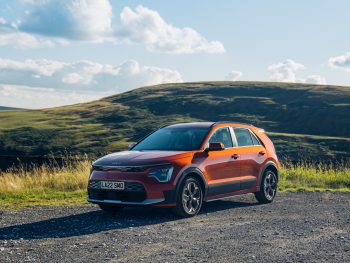First Drive: Kia Niro EV
Kia has surprised many with its EV offerings in recent years, so it’s no surprise that the latest version of one of its most popular models fails to disappoint. By John Challen.

The Niro EV was the second-best selling pure EV in the UK in the first and second quarter of 2022
WHAT IS IT? C-segment electric SUV
HOW MUCH? From £36,345
RANGE? 285 miles
How long to charge 10-80%? 45 minutes (100kW DC charger)
It’s quite a feat for a brand-new model to become the second best-selling vehicle in the car’s company lineup in six years, but that’s what’s happened with the Niro. Since 2016, the crossover has sold more than 75,000 units in the UK, bettered only by the Sportage within the Kia stable.
Launched as a hybrid-only model in 2016, Niro added a PHEV to its portfolio the following year and then a pure electric model (e-Niro) 12 months later. In 2022, there’s an all-new line-up of Niros – retaining the same powertrain threesome as the Mk I. This time around, the bulk of cars (60%) are expected to be the pure electric model – the newly renamed (and de-punctuated) Niro EV.
Across the board, there’s a new look inside and out, improved battery technology, more range and an upgraded interior. Essentially, it ticks a lot of boxes for drivers who are looking to embark on their journey into electric vehicles. If the new Niro EV picks up where the outgoing car left off, Kia will be happy – it was the second-best selling pure EV in the UK in the first and second quarter of 2022!
From the outside, new Niro gets the updated Kia family look, which kicked off with the aforementioned Sportage. Obviously styling cues here include the new-style badge and front headlights. There’s a slightly different appearance to the front-end of the Niro EV compared with the PHEV model, due to the front-mounted plug socket (on the plug-in, drivers will find the port on the front wing). Step inside and there’s a lot of familiarity with the rest of Kia’s newcomers. For example, in comes the switchable infotainment panel that debuted on the EV6, circular gear selector dial and familiar-looking touchscreen. Kia says more sustainable materials have been used in the new Niro – top-of-the-range models boast vegan leather upholstery, for example.
Performance-wise, the Niro EV features a 64.8kWh lithium-ion polymer battery, producing 204hp between 6,000 and 14,600rpm. With instant torque of 255Nm, the car will reach 62mph from a standstill in under eight seconds (7.8) and hit a top speed of 103mph. When it comes to charging, Niro EV’s battery can be replenished from 10% to 80% in 43 minutes with a 350kW rapid charger or, more likely, 45 minutes on a more common 100kW DC unit. Meanwhile, Kia has built in some clever technology into the battery which helps to optimise its performance – available in certain grades. In winter months, navigation-based conditioning is used to pre-heat the battery when a charge point is selected. As a result, charge times are shortened and the system is protected from the rapid change in temperature.
Three grades of Niro EV are available, with a choice of ‘2’, ‘3’ or ‘4’ models. Even the base model ‘2’ – test-driven on the launch – is well equipped and would suit most drivers making the move into an EV. However, the range-topping model offers plenty more, including improved seats and more safety tech. Regardless of model, the Niro’s driving range – clearly a concern for many EV sceptics – is a big plus, too, as is its ability to tow a trailer (a first for a pure-electric Niro).
As a pure EV, the Niro is appealing from the point of view of its range, but beyond that it impresses in many other respects. The controls are well laid-out, with the right mix of physical buttons and touchscreen operation. Seats are comfortable and there is plenty of space for driver and rear passengers. On the move, progress is smooth and relatively swift. There’s the now-familiar instant power offered by all EVs from a standstill, but also in the mid-range, which makes overtaking on motorways, for example, that bit easier.
Being a crossover means that the ride and handling isn’t the sportiest, but pressing on down B-roads the Niro’s body roll is kept to a minimum and the brakes are responsive enough to inspire confidence going into corners. Speaking of brakes, the regenerative braking system is effective – and it helped to achieve a 4.2mpkWh economy figure on our test drive.
The verdict
As the second-best selling Kia in the UK lineup, the Niro has a lot to live up to. Fortunately, it delivers when it comes to interior, spec levels and performance, with competitive pricing added into the mix. There’s a bit of noise while on the move, but low running costs and a decent standard spec will go some way in softening the blow!
There might be faster, sportier and more dynamic-looking EVs out there but, as an all-rounder, the Niro EV takes a lot of beating.
The Lowdown
Key fleet model: Niro EV ‘2’ 64.8kWh
Thumbs up: Driving range; competitive price, boot space
Thumbs down: Road/tyre noise; conservative-looking interior
Seven-word summary: Electric Niro upgrade moves the game on
Also consider: Peugeot e-2008, Volkswagen ID 3, Renault Megané E-Tech Electric












